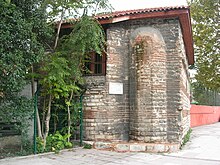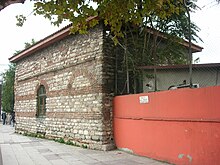Manastir mosque
The Manastır Mosque ( Turkish Manastır Mescidi , also Mustafa Çavuş Mescidi ) is a former Byzantine church and Ottoman mosque in Istanbul . Neither archaeological excavations nor contemporary documents have shed light on the origins of the church. It is possible that the small building was a monastery, in the Byzantine period part the holy Märyterinnen Menodora, Metrodora and Nymphodora ( Greek Μονῆ τῶν Άγίων Μηνοδώρας, Μητροδώρας καὶ Νυμφοδώρας ) ordained was, or part of the nunnery Kyra Martha ( Greek Μονῆ τἠς Κυράς Μάρθας ).
location
The building is located in the Topkapı district in Istanbul's Fatih district in Turgut Özal Millet Caddesi, around 360 meters southeast of the Topkapıtore of the Theodosian Wall .
history
The origins of the structure on the seventh hill of Constantinople are not clear. As the Turkish name suggests (Manastır = English monastery), the building could have been part of the Ta Elebichou monastery , which was dedicated to the martyrs Menodora, Metrodora and Nymphodora and was located near the Romanus Gate (today Topkapıtor). In the first half of the 14th century, a certain Phokas Maroulas, an official at the imperial court, is said to have restored the church and founded a monastery which was dedicated to Theotokos .
According to another hypothesis, the small building could have been part of the Kyra Martha monastery . This was founded in 1268 by Maria, a sister of the Byzantine Emperor Michael VIII. As a widow, she made a religious vows , took the name Martha and founded a monastery that bore her name. This was private ownership of Palaiologoi dynasty. But the precise directions from Stefan von Novgorod and Zosima contradict this.
After Constantinople was conquered by the Ottomans in 1453, Mustafa, a Çavuş and messenger of Sultan Mehmed II , had the building converted into a mescit , a small devotional mosque without a minbar . Between 1956 and 1958, the buildings around the small mosque were demolished during the construction of Turgut Özal Caddesi and the building was no longer used as a prayer room. It is now inside the walls of a bus depot and can only be viewed with the company's approval.
architecture
Due to its small dimensions, the building was probably not a church and more of a prayer room of a monastery. The building has a rectangular floor plan and today only one nave with three small apses in the east and a narthex in the west. The church had three naves (possibly surmounted by a dome) and a three-part bema .
The original decor inside no longer exists. Only two capitals are preserved as part of the triple arcade between the narthex and the naos . The roof and windows were also changed. Excavations in the 1960s have shown that the building's original floor plan was significantly more complex. On the west side there is an outer narthex with a vault, on the south side there is a small chapel with an inner narthex on three sides. Due to the masonry and the floor plan, the building can be dated to the 11th century, although other scholars believe that it could also date from the era of the Komnenes and palaeologists (13th to 15th centuries).
literature
- Raymond Janin: La Géographie Ecclésiastique de l'Empire Byzantin . 1st part: Le Siège de Constantinople et le Patriarcat Oecuménique of the 3rd volume: Les Églises et les Monastères . Institut Français d'Etudes Byzantines. Paris 1953
- Wolfgang Müller-Wiener : Image lexicon on the topography of Istanbul: Byzantion, Konstantinupolis, Istanbul up to the beginning of the 17th century . Wasmuth, Tübingen 1977, ISBN 978-3-8030-1022-3
Web links
Individual evidence
- ↑ a b c Janin (1953), p. 384
- ↑ a b * Semavi Eyice : Istanbul. Petite Guide a travers les Monuments Byzantins et Turcs . Istanbul Matbaası, Istanbul 1955, p. 86
- ↑ Arne Effenberger: The monasteries of the two Kyrai Martha and the church of the Bebaia Elpis monastery in Constantinople . In: Millennium. Yearbook on Culture and History of the First Millennium AD Volume 3, p. 256, footnote 7
- ↑ a b c d e f g Müller-Wiener (1977), p. 194
- ^ Ernest Mamboury : The Tourists' Istanbul . Çituri Biraderler Basımevi, Istanbul 1953, p. 258
Coordinates: 41 ° 1 '2.5 " N , 28 ° 55' 42.2" E


